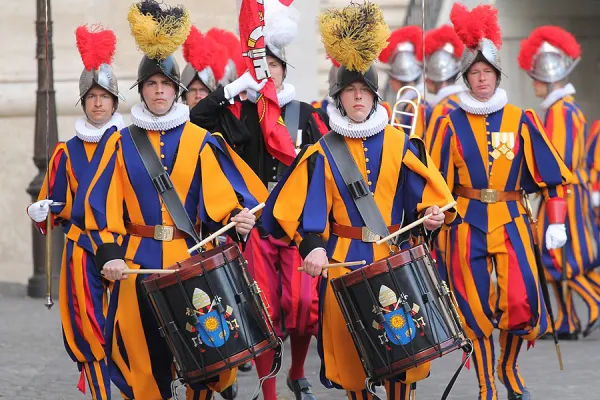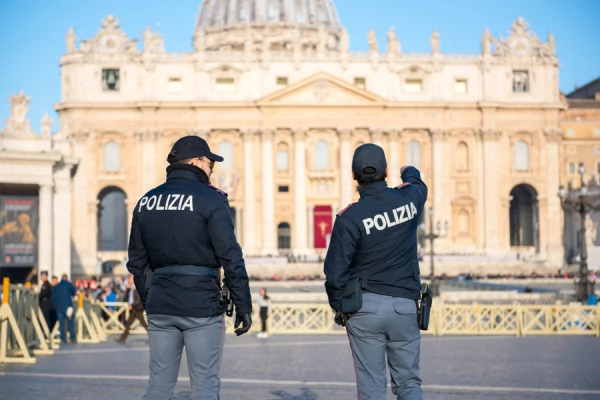
Vatican City, May 6, 2020 / 11:47 am (CNA).- The annual swearing-in of new Swiss Guards, which would usually take place May 6, was moved to Oct. 4 because of the coronavirus.
Instead, the Pontifical Swiss Guards marked Wednesday’s anniversary of the Sack of Rome with private, more muted celebrations, lacking the presence of guests and streamed over the internet.
The Swiss Guards marked the 493rd anniversary of the May 6, 1527 battle with Mass in the church of Santa Maria of the Pieta in the Teutonic College, followed by the “laying of the wreath,” in the Square of the Roman Protomartyrs in Vatican City.
Afterward, the commander of the Swiss Guards conferred papal honorifics on 15 guards.
After Mass, all but the newest members of the world’s smallest-but-oldest standing army marched to Square of the Roman Protomartyrs, so-named for being the site of the death of several early Christian martyrs, including St. Peter.
The Commander of the Swiss Guards, Christoph Graf, gave a speech at the ceremony in which he recounted the story of the 1527 battle known as the Sack of Rome, when 147 guards lost their lives defending Pope Clement VII from mutinous troops of the Holy Roman Empire.
During the battle, the pope was able to escape from the Vatican to Castel Sant’Angelo via a secret passageway connecting the two. It is the most significant and deadly event in the history of the Swiss Guards.
After the speech, a large wreath was placed in the square in commemoration of the guards who died during the battle.
The anniversary is usually marked by a whole weekend of events attended by representatives of the Swiss army, Swiss government, and Swiss bishops’ conference. Family and friends of the guards, and former guards who return for a visit, also participate.
In past years, the festivities have also included a concert and an audience with Pope Francis.
The main celebrant of the May 6 Mass was the assessor of the Secretariat of State, Msgr. Luigi Roberto Cona. In his homily, Cona said he wishes the guards may “truly experience Christ.”
“May you encounter a Church that is not only an institution, an institution to be defended, to be protected, which you have wisely done for 500 years now, but also a community, a believing community which has met the living and true Christ, which loves him, and intends to serve him in everyday life,” he said.
“Because every day we too, in imitation of the first Christian martyrs – and your brother guards who offered themselves at that very important moment in 1527 – we too, without the heroism of those, can offer ourselves day after day in the services we are called to perform.”
If you value the news and views Catholic World Report provides, please consider donating to support our efforts. Your contribution will help us continue to make CWR available to all readers worldwide for free, without a subscription. Thank you for your generosity!
Click here for more information on donating to CWR. Click here to sign up for our newsletter.




Leave a Reply